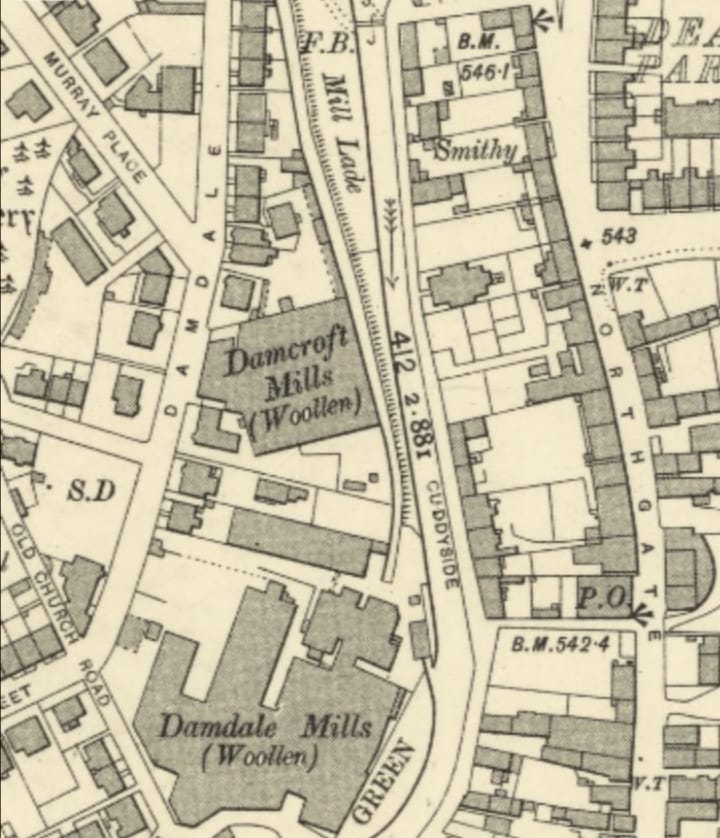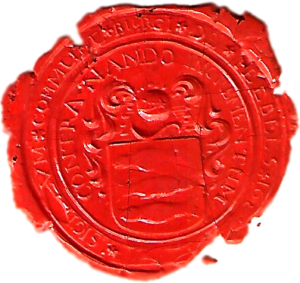On Sunday afternoon (1890-05-25) one of the most disastrous fires, both as regards destruction of property and loss of employment to work people, which has taken place for many years in Peebles, occurred at Damcroft Mills, belonging to Messr Steele, Gardiner & Co.

Shortly after half-past two o’clock on Sunday the word was passed from mouth to mouth that Steele’s Mill was on fire, and most unfortunately this proved to be only too true, and as a natural consequence with the spread of the ill-fated news crowds rushed to the scene up the Cuddyside and also to the front of the buildings in Damdale. It was at first reported that the fire had broken out amongst an accumulation of waste in the waste house, but as this material was removed regularly during the week, some other theory for the outbreak had to be found and it now seems pretty evident that the fire originated in the south-east corner, closely adjoining the dam on the Eddleston Water, in a compartment which was used as a yarn store. How the fire originated is to a great extent a mystery, but the only feasible theory is that with the strong sun’s rays that forenoon reflected from the glass on the yarns inside, there had been a case of spontaneous combustion.
We understand that the whole premises were inspected on Sunday morning by Mr John Colthard, and were found perfectly secure, with not the slightest indication of anything being amiss. At the time we have specified – nearly three o’clock in the afternoon – the alarm was given, but by that time the yarn store adjoining the dam was in a blaze. Without loss of time, the fire-brigade and the fire engine were on the scene, but it was evident soon after the discovery of the outbreak that all the appliances that could be brought to bear on the burning mass would be useless, owing to the fire having got such a firm hold before it was discovered. The fire spread from one department of the works to another as quickly as if a train of gunpowder had been laid between them and in little more than an hour after the discovery of the outbreak nothing was left but the blackened walls, with the roofs all gone, the valuable machinery including the looms and other adjuncts, completely wrecked and the whole a perfectly useless mass of twisted and destroyed pieces of mechanism. So quick indeed was the progress of the fire fiend, that the work of destruction was completed before one could realise it had begun.
As we have stated, the factory seemed doomed from the very first and neither water nor fire engine appliances could have saved it. There was an evident want of organisation on the part of the fire brigade, but Fire-Master Charles T. Ker, Captain Fairbairn and the other members worked manfully and did their very best. But with the odds against them, it was impossible they could rescue the burning pile and with praiseworthy energy, their efforts were directed to the saving of the adjoining properties. A house in close proximity to the factory, belonging to Bailie Wilson and occupied by Mr James Greig and Mr Thomas Black, was for some time in imminent danger as the wind was blowing the flames right over it. A wooden erection at the back was speedily consumed by the flames, but just at the most critical moment, when it appeared that the dwelling-house would inevitably fall a prey to the devouring element which was carrying all before it, the wind in a second changed and drove the flames in a more westerly direction, over to Newton Villa and the cottages of Messrs James and David Murray on the opposite side of the road. Newton Villa, occupied by Mr J. J. Finlay, organist, Parish Church, and the premises of the Messrs Murray, were for a time in a position of great jeopardy, indeed a wooden finial on Mr James Murray’s house caught fire, but it was promptly suppressed. The factory’ of Messrs Thorburn Brothers was also at one time in great danger. The dye-house of the firm once or twice caught fire, but happily it was noticed in time. Messrs E. Bououg, A. Ruckbie, and J. Brodie, mounted to the top, and with pails of water succeeded in preventing the fire from spreading, otherwise the consequences might have been far more serious than they were.
As it was, the mill of Messrs Steele, Gardiner & Co., was completely destroyed. There were fifty-one looms in the building and two had been put in only about a fortnight before. Fully two hundred hands have been thrown out of employment, and the total damage is roughly estimated at nearly £30,000.
This has been the most destructive fire which has occurred in Peebles for nearly thirty-six years, when the meal mill was burned down in October 1854. Fortunately, the premises and machinery were all fully insured. The greater part of the finished goods in the building were saved by great exertions by a host of willing hands, some of whom, including Councillor Montgomery and Mr John Watson, coal-agent, had a narrow escape, owing to the floor giving way under them. It is however, gratifying to learn that no one, amidst the confusion and excitement which prevailed, sustained any serious injury.
The scene of the fire was visited by large numbers on Sunday evening and on Monday, up to which time the debris continued to smoulder. During the night a number of watchers were in attendance in case of any renewed outbreak taking place, and water was poured at intervals on the smouldering mass. Among the sufferers by the destruction of their household furniture owing to its hurried removal were Mr Finlay, Mr T. Black, and Mr James Greig. In the excitement of the moment this was almost unavoidable, the object being to save as much as possible from the flames which, to all appearance, were about to catch on to the houses.
It was a regrettable sight to see many valuable articles almost entirely destroyed and rendered useless. While the fire brigade and many others worked very hard and did their utmost to keep the fire from spreading, it was only too evident that at the beginning of the outbreak and for some time after, there was a great scarcity of water. To obviate this as much as possible, a number of people formed themselves into a line stretching from the front of the mill to the dam and passed pails of water from hand to hand for the supply of the fire-engine. Another row of people passed the pails as they were emptied down to the dam again to be refilled, and thus for a time the engine was kept supplied. Latterly a more plentiful supply of water was obtained from a fire plug {hydrant} opposite the burning building, but by the time it was got, the fire had well-nigh burned itself out.
It was a very fortunate circumstance that the mill of Messrs Thorburn Brothers was prevented from catching fire, as if it had it would have been difficult to tell where it would have ended. The general impression appeared to be that if it had caught the houses in the Biggiesknowe district would have been placed in great danger and the consequences to the town would have been much more serious by a larger number of workpeople being thrown out of employment. We are glad to learn that arrangements are being made by which Messrs Steele, Gardiner & Co. will be enabled to afford employment to a considerable proportion of their old hands. Regarding the organisation of the fire brigade, we commend to the attention of the authorities, a letter in another column from Sir John A. Hay, Bart., who was an active worker at the fire. We have much pleasure in recording that Sir John A. Hay, Bart., has in the most generous manner placed the handsome sum of £10 at the disposal of the firm for the benefit of the workers who have been thrown idle by the fire. This sum, the firm have handed over to Provost Mathison for distribution among the work people.
1890-05-31, SID64_p3_c5
